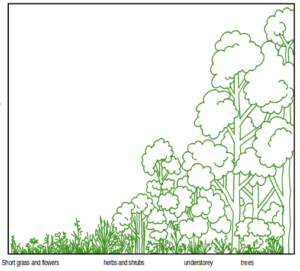Ancient Woodland
Ancient woodland is defined as woodland which has been in continuous existence since at least the year 1600. It is irreplaceable and should be strongly protected. There would have to be an exceptionally good case to be made for removal of any ancient woodland. The great losses of old woodland that have occurred are well known, and new woodland creation is a popular option. However, old woodland is a very complex habitat. It takes time for woodland to develop this complexity. It is estimated that it may take 400 years for a new woodland plantation to fully establish.

A graded edge to woodland provides a wider variety of habitat and encourages a
wider variety of species. Retain or Create and manage a series of layers, from short to long grass to shrubs to understorey to trees.
Characteristics
Woodland is more than just trees, being structured as a number of layers. These start on the ground as the field layer, where wildflowers like Bluebell grow. Above this is the understorey of Brambles, shrubs and young trees; then comes another layer of smaller trees like Hawthorn and Hazel. Finally over the top is the canopy layer of mature trees like Oak, Ash, Field Maple or Lime. Many of the trees will be dead, and this together with dead branches and dead wood on the ground forms valuable habitat as well.
Importance
Many animals of the woodlands depend on more than one layer. Bats will roost in cracks in large old trees, but feed on the insects that are there because of the flowers on the ground. Birds may nest in the shrub layer, or in holes in old trees, but they feed throughout the layers of the woodland. The whole of the woodland vegetation is linked together underground by a network of fungi whose threads penetrate the soil and the roots of plants, and these threads move nutrients around from plant to plant.
In general the older and more natural the woodland the greater is its nature conservation value
Management
There are few wholly natural woodlands however, most having been managed for some purpose, coppiced for wood and timber production or kept for game shooting. The way a wood is managed is very important, and even where neglected these woodlands can be enhanced by suitable management. Improved management of existing woodland can be a more important a planning gain than new planting.
New woodland planting
Woodland and trees should not be planted on sites which already have a wildlife value, like flower rich grassland or heathland. For those who want more woodland but who cannot wait centuries for natural regeneration, new woodland plantings should mimic the features of old woodland, and where possible link to them. Use a variety of species appropriate to the area, with plants of local origin when possible, and the National Vegetation Classification is a useful guide to woodland types. Plant trees randomly, not in rows. Plant the field layer and the understorey too, with rides and glades kept open for the wildflowers and butterflies. If the site is large enough, think about including a pond too. Glades, rides and the woodland edge are valuable areas, with variation of sunny, humid and sheltered conditions.
Further information
There is plenty of advice on woodland creation, in books and on the internet. Look at these references to start;
http://www.forestry.gov.uk/keepersoftime
Managing Ancient and Native Woodland in England
https://www.forestry.gov.uk/pdf/FCPG201.pdf/$FILE/FCPG201.pdf
Managing Ancient and Native Woodland
https://www.forestry.gov.uk/pdf/prog-aw-practice-guide.pdf/$FILE/prog-aw-practice-guide.pdf
https://www.forestry.gov.uk/pdf/FCPG201.pdf/$FILE/FCPG201.pdf
Deer management
A word of caution; many woodlands are now heavily over-populated with Deer. Though these animals are popular with visitors, they are herbivores and will eat all fresh young growth. In some woodlands deer have eliminated the ground flora, they prevent tree regeneration from seed, and they can wreck new plantations. All species of deer need to be kept under control, and there is plenty of advice available on this matter, the following links are a good place to begin.
The Deer initiative
http://www.thedeerinitiative.co.uk
Managing Deer in the Countryside
https://www.forestry.gov.uk/pdf/fcpn6.pdf/$FILE/fcpn6.pdf
The Impact of Deer on Woodland Biodiversity
https://www.forestry.gov.uk/PDF/FCIN036.pdf/$FILE/FCIN036.pdf
Managing Deer for Woodland Biodiversity
https://www.forestry.gov.uk/pdf/Managingdeerforwoodlandbiodiversity.pdf/$FILE/Managingdeerforwoodlandbiodiversity.pdf
